Structure-Dependent Toxicokinetics of Selected Pyrrolizidine Alkaloids In Vitro
Abstract
:1. Introduction
2. Results
2.1. Intestinal Transfer Rate of PAs Is Structure-Dependent
2.2. Human Intestinal Microsomes Do Not Significantly Degrade PAs
2.3. Human Liver Microsomes Reduce the Concentration of PAs in a Structure-Dependent Manner
2.4. Human Lung Microsomes Reduce the Concentration of PAs in a Structure-Dependent Manner
2.5. Human Liver and Lung Microsomes Can Bioactivate Lasiocarpine and Monocrotaline to Induce Apoptosis in A549 Cells
2.6. CYP3A4 Is the Most Important CYP Enzyme Metabolizing Lasiocarpine
3. Discussion
4. Materials and Methods
4.1. Chemicals
4.2. Cell Culture
4.2.1. Caco-2 Cells
4.2.2. A549 Cells
4.2.3. Incubation of PAs with Microsomes and Recombinant Human Microsomes
4.2.4. LC-MS/MS
4.3. Detection of Apoptosis
4.3.1. Plasma Membrane Asymmetry Detection with Flow Cytometry
4.3.2. Caspase 3 Activity
4.3.3. Statistics
Supplementary Materials
Author Contributions
Funding
Institutional Review Board Statement
Informed Consent Statement
Data Availability Statement
Acknowledgments
Conflicts of Interest
References
- Stegelmeier, B.; Edgar, J.; Colegate, S.; Gardner, D.; Schoch, T.; Coulombe, R.; Molyneux, R. Pyrrolizidine alkaloid plants, metabolism and toxicity. J. Nat. Toxins 1999, 8, 95–116. [Google Scholar] [CrossRef] [PubMed]
- Wiedenfeld, H.; Röder, E.; Bourauel, T.; Edgar, J. Pyrrolizidine Alkaloids: Structure and Toxicity; V&R unipress GmbH: Goettingen, Germany, 2008. [Google Scholar]
- BfR (German Federal Institute for Risk Assessment). Aktualisierte Risikobewertung zu Gehalten an 1,2-ungesättigten Pyrrolizidinalkaloiden (PA) in Lebensmitteln. Stellungnahme 026/2020; BfR: Berlin, Germany, 2020. [Google Scholar] [CrossRef]
- Fu, P.P.; Xia, Q.; Lin, G.; Chou, M.W. Pyrrolizidine alkaloids—Genotoxicity, metabolism enzymes, metabolic activation, and mechanisms. Drug Metab. Rev. 2004, 36, 1–55. [Google Scholar] [CrossRef] [PubMed]
- Mattocks, A.; White, I. Pyrrolic metabolites from non-toxic pyrrolizidine alkaloids. Nat. New Biol. 1971, 231, 114–115. [Google Scholar] [CrossRef] [PubMed]
- Fox, D.W.; Hart, M.C.; Bergeson, P.S.; Jarrett, P.B.; Stillman, A.E.; Huxtable, R.J. Pyrrolizidine (Senecio) intoxication mimicking Reye syndrome. J. Pediatr. 1978, 93, 980–982. [Google Scholar] [CrossRef]
- Kakar, F.; Akbarian, Z.; Leslie, T.; Mustafa, M.L.; Watson, J.; van Egmond, H.P.; Omar, M.F.; Mofleh, J. An outbreak of hepatic veno-occlusive disease in Western Afghanistan associated with exposure to wheat flour contaminated with pyrrolizidine alkaloids. J. Toxicol. 2010, 2010, 313280. [Google Scholar] [CrossRef] [PubMed]
- Stillman, A.E.; Huxtable, R.; Consroe, P.; Kohnen, P.; Smith, S. Hepatic veno-occlusive disease due to pyrrolizidine (Senecio) poisoning in Arizona. Gastroenterology 1977, 73, 349–352. [Google Scholar] [CrossRef]
- NIH (National Institutes of Health). NTP Technical Report on the Toxicity Studies of Riddelliine (CAS No. 23246-96-0) Administered by Gavage to F344 Rats and B6C3F1 Mice. In Toxicity Report Series 27; NIH Publication No. 94-3350; NIH: Bethesda, MD, USA, 1993. [Google Scholar]
- Ruan, J.; Yang, M.; Fu, P.; Ye, Y.; Lin, G. Metabolic activation of pyrrolizidine alkaloids: Insights into the structural and enzymatic basis. Chem. Res. Toxicol. 2014, 27, 1030–1039. [Google Scholar] [CrossRef]
- Moreira, R.; Pereira, D.M.; Valentão, P.; Andrade, P.B. Pyrrolizidine alkaloids: Chemistry, pharmacology, toxicology and food safety. Int. J. Mol. Sci. 2018, 19, 1668. [Google Scholar] [CrossRef]
- He, Y.; Lian, W.; Ding, L.; Fan, X.; Ma, J.; Zhang, Q.-Y.; Ding, X.; Lin, G. Lung injury induced by pyrrolizidine alkaloids depends on metabolism by hepatic cytochrome P450s and blood transport of reactive metabolites. Arch. Toxicol. 2021, 95, 103–116. [Google Scholar] [CrossRef]
- Hoorn, C.; Roth, R. Monocrotaline pyrrole alters DNA, RNA and protein synthesis in pulmonary artery endothelial cells. Am. J. Physiol.-Lung Cell. Mol. Physiol. 1992, 262, 740–747. [Google Scholar] [CrossRef]
- Yang, Y.-C.; Yan, J.; Doerge, D.R.; Chan, P.-C.; Fu, P.P.; Chou, M.W. Metabolic activation of the tumorigenic pyrrolizidine alkaloid, riddelliine, leading to DNA adduct formation in vivo. Chem. Res. Toxicol. 2001, 14, 101–109. [Google Scholar] [CrossRef] [PubMed]
- Hessel, S.; Gottschalk, C.; Schumann, D.; These, A.; Preiss-Weigert, A.; Lampen, A. Structure–activity relationship in the passage of different pyrrolizidine alkaloids through the gastrointestinal barrier: ABCB1 excretes heliotrine and echimidine. Mol. Nutr. Food Res. 2014, 58, 995–1004. [Google Scholar] [CrossRef] [PubMed]
- Enge, A.-M.; Kaltner, F.; Gottschalk, C.; Braeuning, A.; Hessel-Pras, S. Active transport of hepatotoxic pyrrolizidine alkaloids in HepaRG cells. Int. J. Mol. Sci. 2021, 22, 3821. [Google Scholar] [CrossRef] [PubMed]
- Enge, A.M.; Kaltner, F.; Gottschalk, C.; Kin, A.; Kirstgen, M.; Geyer, J.; These, A.; Hammer, H.; Pötz, O.; Braeuning, A. Organic Cation Transporter I and Na+/taurocholate Co-Transporting Polypeptide are Involved in Retrorsine-and Senecionine-Induced Hepatotoxicity in HepaRG cells. Mol. Nutr. Food Res. 2022, 66, 2100800. [Google Scholar] [CrossRef] [PubMed]
- Tu, M.; Li, L.; Lei, H.; Ma, Z.; Chen, Z.; Sun, S.; Xu, S.; Zhou, H.; Zeng, S.; Jiang, H. Involvement of organic cation transporter 1 and CYP3A4 in retrorsine-induced toxicity. Toxicology 2014, 322, 34–42. [Google Scholar] [CrossRef]
- Tu, M.; Sun, S.; Wang, K.; Peng, X.; Wang, R.; Li, L.; Zeng, S.; Zhou, H.; Jiang, H. Organic cation transporter 1 mediates the uptake of monocrotaline and plays an important role in its hepatotoxicity. Toxicology 2013, 311, 225–230. [Google Scholar] [CrossRef]
- Ebmeyer, J.; Braeuning, A.; Glatt, H.; These, A.; Hessel-Pras, S.; Lampen, A. Human CYP3A4-mediated toxification of the pyrrolizidine alkaloid lasiocarpine. Food Chem. Toxicol. 2019, 130, 79–88. [Google Scholar] [CrossRef]
- Fashe, M.M.; Juvonen, R.O.; Petsalo, A.; Vepsäläinen, J.; Pasanen, M.; Rahnasto-Rilla, M. In silico prediction of the site of oxidation by cytochrome P450 3A4 that leads to the formation of the toxic metabolites of pyrrolizidine alkaloids. Chem. Res. Toxicol. 2015, 28, 702–710. [Google Scholar] [CrossRef]
- Geburek, I.; Preiss-Weigert, A.; Lahrssen-Wiederholt, M.; Schrenk, D.; These, A. In vitro metabolism of pyrrolizidine alkaloids–Metabolic degradation and GSH conjugate formation of different structure types. Food Chem. Toxicol. 2020, 135, 110868. [Google Scholar] [CrossRef]
- Ding, X.; Kaminsky, L.S. Human extrahepatic cytochromes P450: Function in xenobiotic metabolism and tissue-selective chemical toxicity in the respiratory and gastrointestinal tracts. Annu. Rev. Pharmacol. Toxicol. 2003, 43, 149. [Google Scholar] [CrossRef]
- Anttila, S.; Hukkanen, J.; Hakkola, J.; Stjernvall, T.; Beaune, P.; Edwards, R.J.; Boobis, A.R.; Pelkonen, O.; Raunio, H. Expression and localization of CYP3A4 and CYP3A5 in human lung. Am. J. Respir. Cell Mol. Biol. 1997, 16, 242–249. [Google Scholar] [CrossRef] [PubMed]
- Glück, J.; Waizenegger, J.; Braeuning, A.; Hessel-Pras, S. Pyrrolizidine alkaloids induce cell death in human heparg cells in a structure-dependent manner. Int. J. Mol. Sci. 2020, 22, 202. [Google Scholar] [CrossRef] [PubMed]
- Rutz, L.; Gao, L.; Küpper, J.-H.; Schrenk, D. Structure-dependent genotoxic potencies of selected pyrrolizidine alkaloids in metabolically competent HepG2 cells. Arch. Toxicol. 2020, 94, 4159–4172. [Google Scholar] [CrossRef]
- Gao, L.; Rutz, L.; Schrenk, D. Structure-dependent hepato-cytotoxic potencies of selected pyrrolizidine alkaloids in primary rat hepatocyte culture. Food Chem. Toxicol. 2020, 135, 110923. [Google Scholar] [CrossRef] [PubMed]
- Estep, J.; Lame, M.; Morin, D.; Jones, A.; Wilson, D.W.; Segall, H. [14C] monocrotaline kinetics and metabolism in the rat. Drug Metab. Dispos. 1991, 19, 135–139. [Google Scholar]
- Lamé, M.W.; Jones, A.D.; Wilson, D.W.; Segall, H. Monocrotaline pyrrole targets proteins with and without cysteine residues in the cytosol and membranes of human pulmonary artery endothelial cells. Proteomics 2005, 5, 4398–4413. [Google Scholar] [CrossRef]
- Fu, P.P. Pyrrolizidine alkaloids: Metabolic activation pathways leading to liver tumor initiation. Chem. Res. Toxicol. 2017, 30, 81–93. [Google Scholar] [CrossRef]
- Chen, T.; Mei, N.; Fu, P.P. Genotoxicity of pyrrolizidine alkaloids. J. Appl. Toxicol. 2010, 30, 183–196. [Google Scholar] [CrossRef]
- Frei, H.; Lüthy, J.; Brauchli, J.; Zweifel, U.; Würgler, F.E.; Schlatter, C. Structure/activity relationships of the genotoxic potencies of sixteen pyrrolizidine alkaloids assayed for the induction of somatic mutation and recombination in wing cells of Drosophila melanogaster. Chem. Biol. Interact. 1992, 83, 1–22. [Google Scholar] [CrossRef]
- Fu, P.; Chou, M.; Xia, Q.; Yang, Y.-C.; Yan, J.; Doerge, D.; Chan, P. Genotoxic pyrrolizidine alkaloids and pyrrolizidine alkaloid N-oxides—Mechanisms leading to DNA adduct formation and tumorigenicity. J. Environ. Sci. Health Part C 2001, 19, 353–385. [Google Scholar] [CrossRef]
- Zheng, P.; Xu, Y.; Ren, Z.; Wang, Z.; Wang, S.; Xiong, J.; Zhang, H.; Jiang, H. Toxic prediction of pyrrolizidine alkaloids and structure-dependent induction of apoptosis in HepaRG cells. Oxidative Med. Cell. Longev. 2021, 2021, 8822304. [Google Scholar] [CrossRef] [PubMed]
- Mattocks, A. Toxicity of pyrrolizidine alkaloids. Nature 1968, 217, 723–728. [Google Scholar] [CrossRef]
- Gundert-Remy, U.; Bernauer, U.; Blömeke, B.; Döring, B.; Fabian, E.; Goebel, C.; Hessel, S.; Jäckh, C.; Lampen, A.; Oesch, F. Extrahepatic metabolism at the body’s internal–external interfaces. Drug Metab. Rev. 2014, 46, 291–324. [Google Scholar] [CrossRef] [PubMed]
- Buchmueller, J.; Enge, A.-M.; Peters, A.; Ebmeyer, J.; Küpper, J.-H.; Schäfer, B.; Braeuning, A.; Hessel-Pras, S. The chemical structure impairs the intensity of genotoxic effects promoted by 1, 2-unsaturated pyrrolizidine alkaloids in vitro. Food Chem. Toxicol. 2022, 164, 113049. [Google Scholar] [CrossRef] [PubMed]
- Louisse, J.; Rijkers, D.; Stoopen, G.; Holleboom, W.J.; Delagrange, M.; Molthof, E.; Mulder, P.P.; Hoogenboom, R.L.; Audebert, M.; Peijnenburg, A.A. Determination of genotoxic potencies of pyrrolizidine alkaloids in HepaRG cells using the γH2AX assay. Food Chem. Toxicol. 2019, 131, 110532. [Google Scholar] [CrossRef] [PubMed]
- Yang, M.; Ma, J.; Ruan, J.; Ye, Y.; Fu, P.P.-C.; Lin, G. Intestinal and hepatic biotransformation of pyrrolizidine alkaloid N-oxides to toxic pyrrolizidine alkaloids. Arch. Toxicol. 2019, 93, 2197–2209. [Google Scholar] [CrossRef]
- Xia, Q.; Chou, M.W.; Kadlubar, F.F.; Chan, P.-C.; Fu, P.P. Human liver microsomal metabolism and DNA adduct formation of the tumorigenic pyrrolizidine alkaloid, riddelliine. Chem. Res. Toxicol. 2003, 16, 66–73. [Google Scholar] [CrossRef]
- Lu, Y.; Wong, K.Y.; Tan, C.; Ma, J.; Feng, B.; Lin, G. Establishment of a novel CYP3A4-transduced human hepatic sinusoidal endothelial cell model and its application in screening hepatotoxicity of pyrrolizidine alkaloids. J. Environ. Sci. Health Part C 2020, 38, 169–185. [Google Scholar] [CrossRef]
- Dai, J.; Zhang, F.; Zheng, J. Retrorsine, but not monocrotaline, is a mechanism-based inactivator of P450 3A4. Chem.-Biol. Interact. 2010, 183, 49–56. [Google Scholar] [CrossRef]
- Kolrep, F.; Numata, J.; Kneuer, C.; Preiss-Weigert, A.; Lahrssen-Wiederholt, M.; Schrenk, D.; These, A. In vitro biotransformation of pyrrolizidine alkaloids in different species. Part I: Microsomal degradation. Arch. Toxicol. 2018, 92, 1089–1097. [Google Scholar] [CrossRef]
- Zanger, U.M.; Schwab, M. Cytochrome P450 enzymes in drug metabolism: Regulation of gene expression, enzyme activities, and impact of genetic variation. Pharmacol. Ther. 2013, 138, 103–141. [Google Scholar] [CrossRef] [PubMed]
- Kishimoto, Y.; Kato, T.; Ito, M.; Azuma, Y.; Fukasawa, Y.; Ohno, K.; Kojima, S. Hydrogen ameliorates pulmonary hypertension in rats by anti-inflammatory and antioxidant effects. J. Thorac. Cardiovasc. Surg. 2015, 150, 645–654.e3. [Google Scholar] [CrossRef] [PubMed]
- Xiao, G.; Wang, T.; Zhuang, W.; Ye, C.; Luo, L.; Wang, H.; Lian, G.; Xie, L. RNA sequencing analysis of monocrotaline-induced PAH reveals dysregulated chemokine and neuroactive ligand receptor pathways. Aging 2020, 12, 4953. [Google Scholar] [CrossRef] [PubMed]
- Song, Z.; He, Y.; Ma, J.; Fu, P.P.; Lin, G. Pulmonary toxicity is a common phenomenon of toxic pyrrolizidine alkaloids. J. Environ. Sci. Health Part C 2020, 38, 124–140. [Google Scholar] [CrossRef]
- Lafranconi, W.M.; Huxtable, R.J. Hepatic metabolism and pulmonary toxicity of monocrotaline using isolated perfused liver and lung. Biochem. Pharmacol. 1984, 33, 2479–2484. [Google Scholar] [CrossRef]
- Mattocks, A.R.; Jukes, R. Trapping and measurement of short-lived alkylating agents in a recirculating flow system. Chem. Biol. Interact. 1990, 76, 19–30. [Google Scholar] [CrossRef]
- Pan, L.C.; Lamé, M.W.; Morin, D.; Wilson, D.W.; Segall, H. Red blood cells augment transport of reactive metabolites of monocrotaline from liver to lung in isolated and tandem liver and lung preparations. Toxicol. Appl. Pharmacol. 1991, 110, 336–346. [Google Scholar] [CrossRef]
- Porter, A.G.; Jänicke, R.U. Emerging roles of caspase-3 in apoptosis. Cell Death Differ. 1999, 6, 99–104. [Google Scholar] [CrossRef]
- Hincks, J.R.; Kim, H.Y.; Segall, H.J.; Molyneux, R.J.; Stermitz, F.R.; Coulombe, R.A., Jr. DNA cross-linking in mammalian cells by pyrrolizidine alkaloids: Structure-activity relationships. Toxicol. Appl. Pharmacol. 1991, 111, 90–98. [Google Scholar] [CrossRef]
- He, Y.; Ma, J.; Fan, X.; Ding, L.; Ding, X.; Zhang, Q.-Y.; Lin, G. The key role of gut–liver axis in pyrrolizidine alkaloid-induced hepatotoxicity and enterotoxicity. Acta Pharm. Sin. B 2021, 11, 3820–3835. [Google Scholar] [CrossRef]
- Allemang, A.; Mahony, C.; Lester, C.; Pfuhler, S. Relative potency of fifteen pyrrolizidine alkaloids to induce DNA damage as measured by micronucleus induction in HepaRG human liver cells. Food Chem. Toxicol. 2018, 121, 72–81. [Google Scholar] [CrossRef] [PubMed]
- Fossati, L.; Dechaume, R.; Hardillier, E.; Chevillon, D.; Prevost, C.; Bolze, S.; Maubon, N. Use of simulated intestinal fluid for Caco-2 permeability assay of lipophilic drugs. Int. J. Pharm. 2008, 360, 148–155. [Google Scholar] [CrossRef] [PubMed]
- Hilgers, A.R.; Conradi, R.A.; Burton, P.S. Caco-2 cell monolayers as a model for drug transport across the intestinal mucosa. Pharm. Res. 1990, 7, 902–910. [Google Scholar] [CrossRef] [PubMed]
- Kaltner, F.; Stiglbauer, B.; Rychlik, M.; Gareis, M.; Gottschalk, C. Development of a sensitive analytical method for determining 44 pyrrolizidine alkaloids in teas and herbal teas via LC-ESI-MS/MS. Anal. Bioanal. Chem. 2019, 411, 7233–7249. [Google Scholar] [CrossRef] [PubMed]
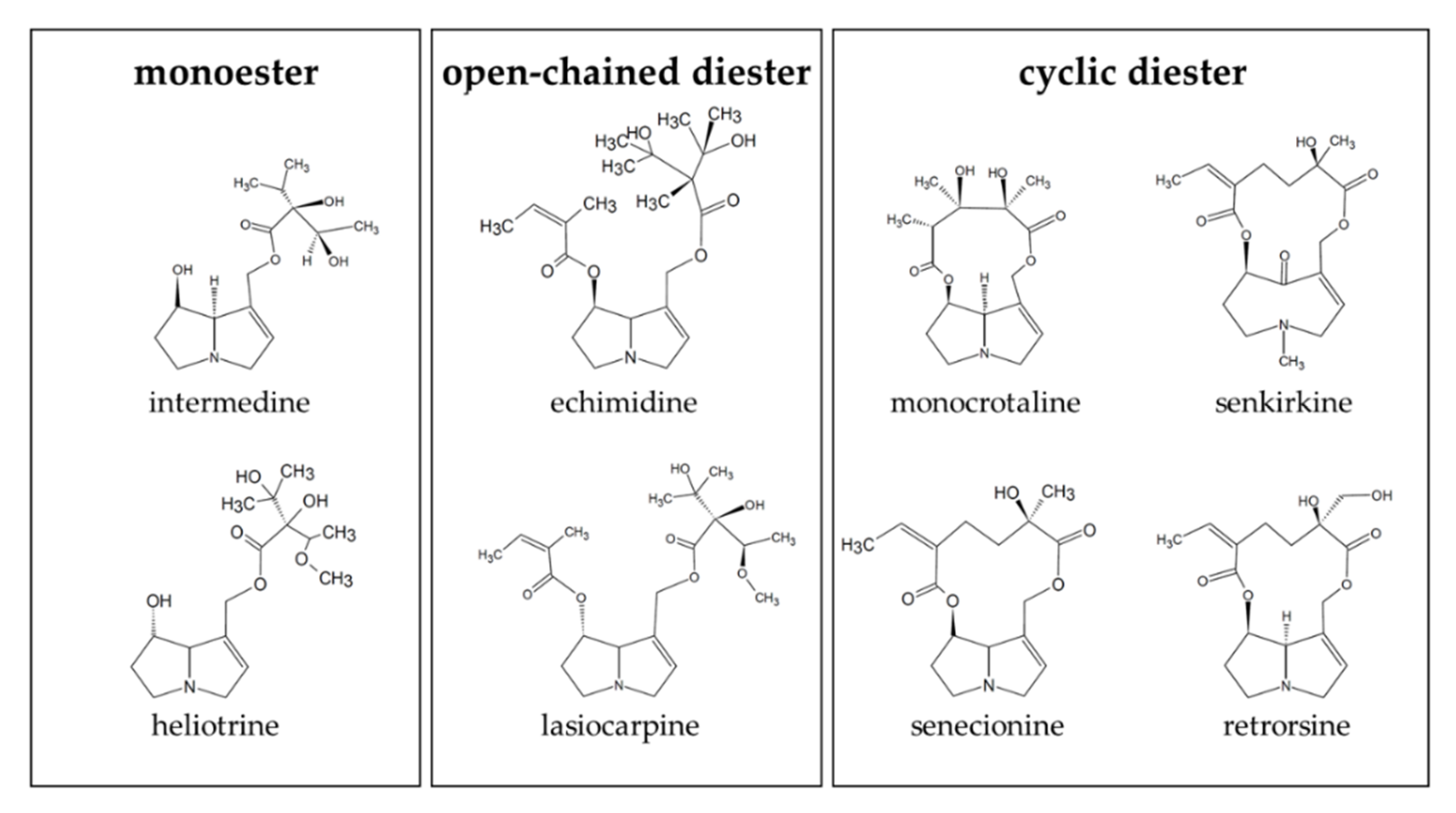

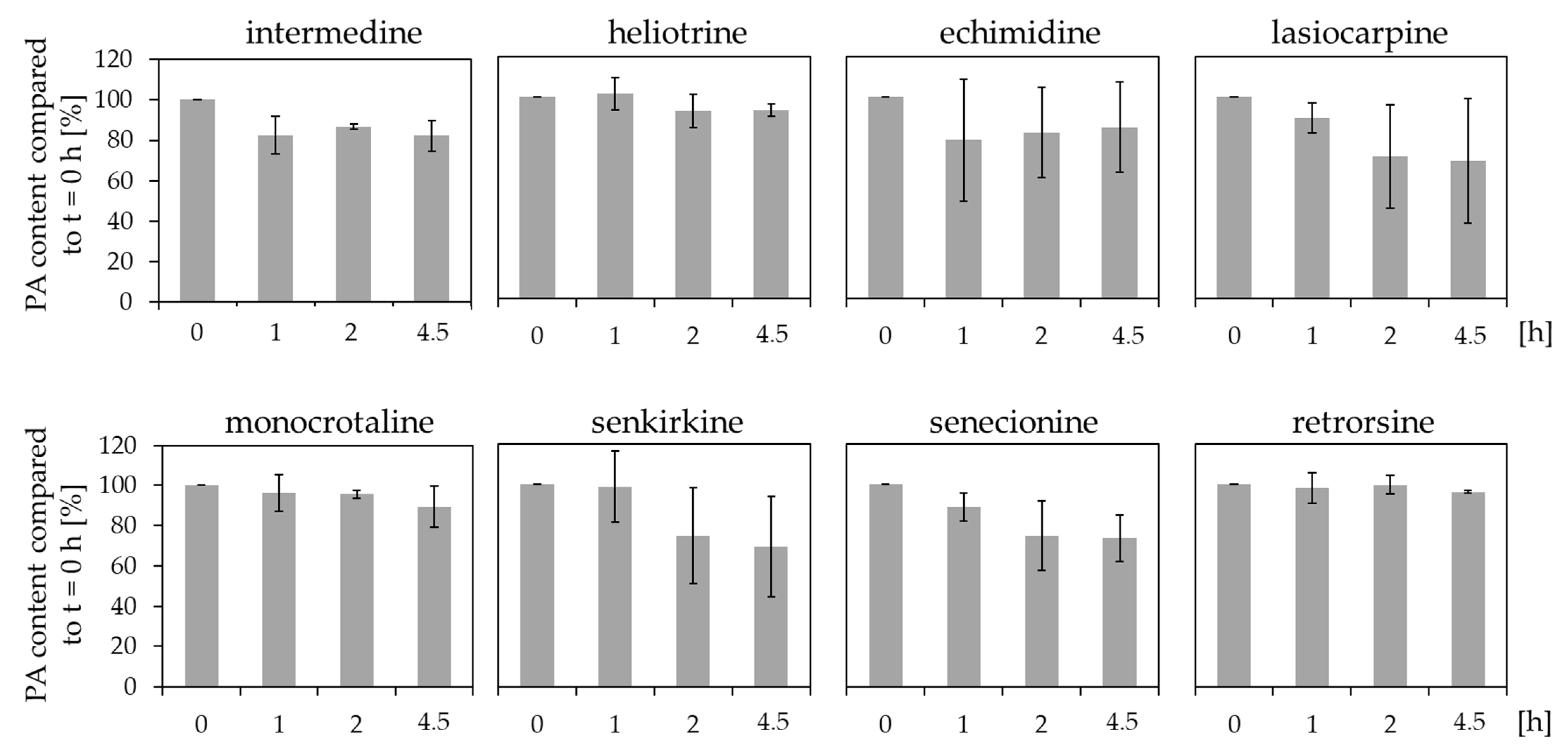
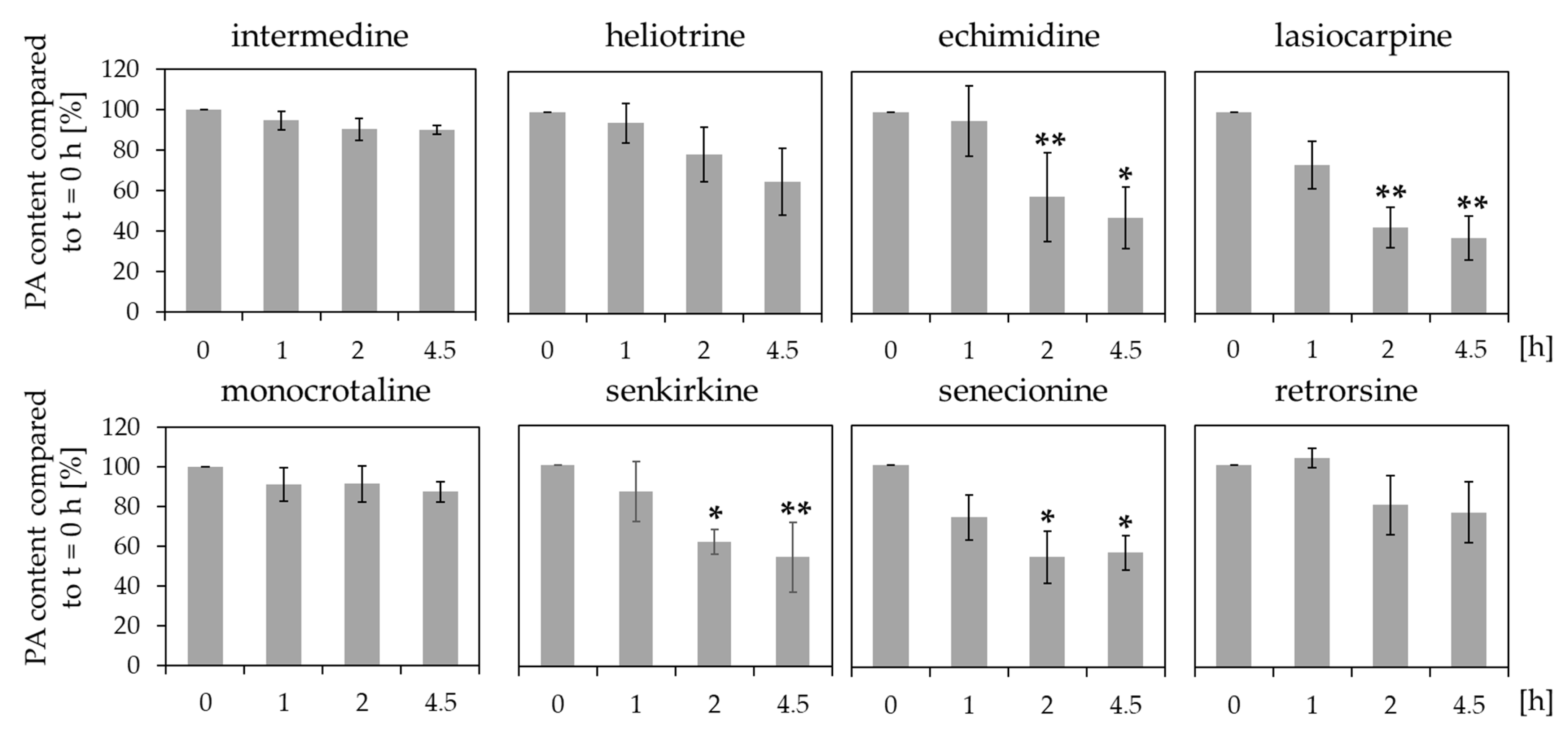
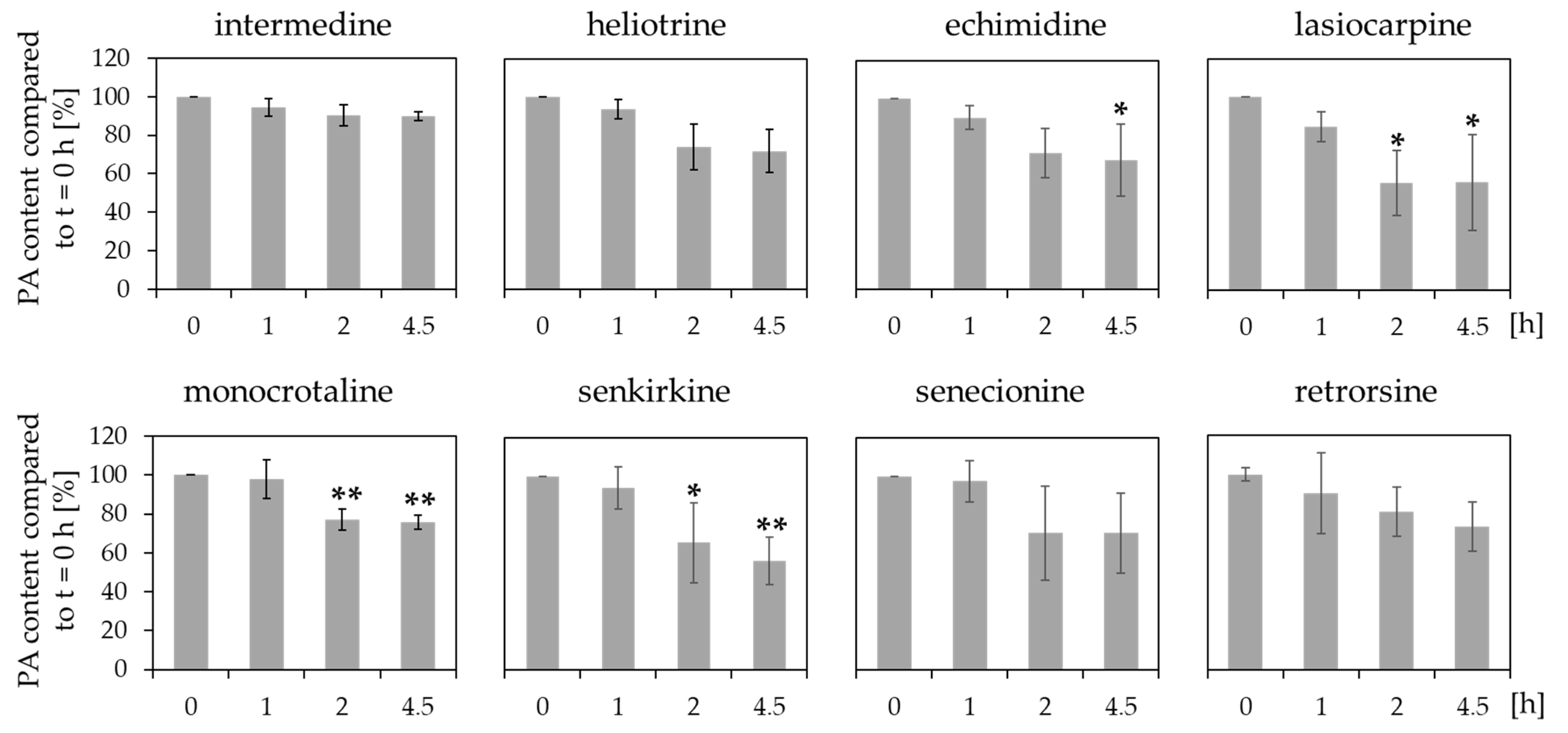
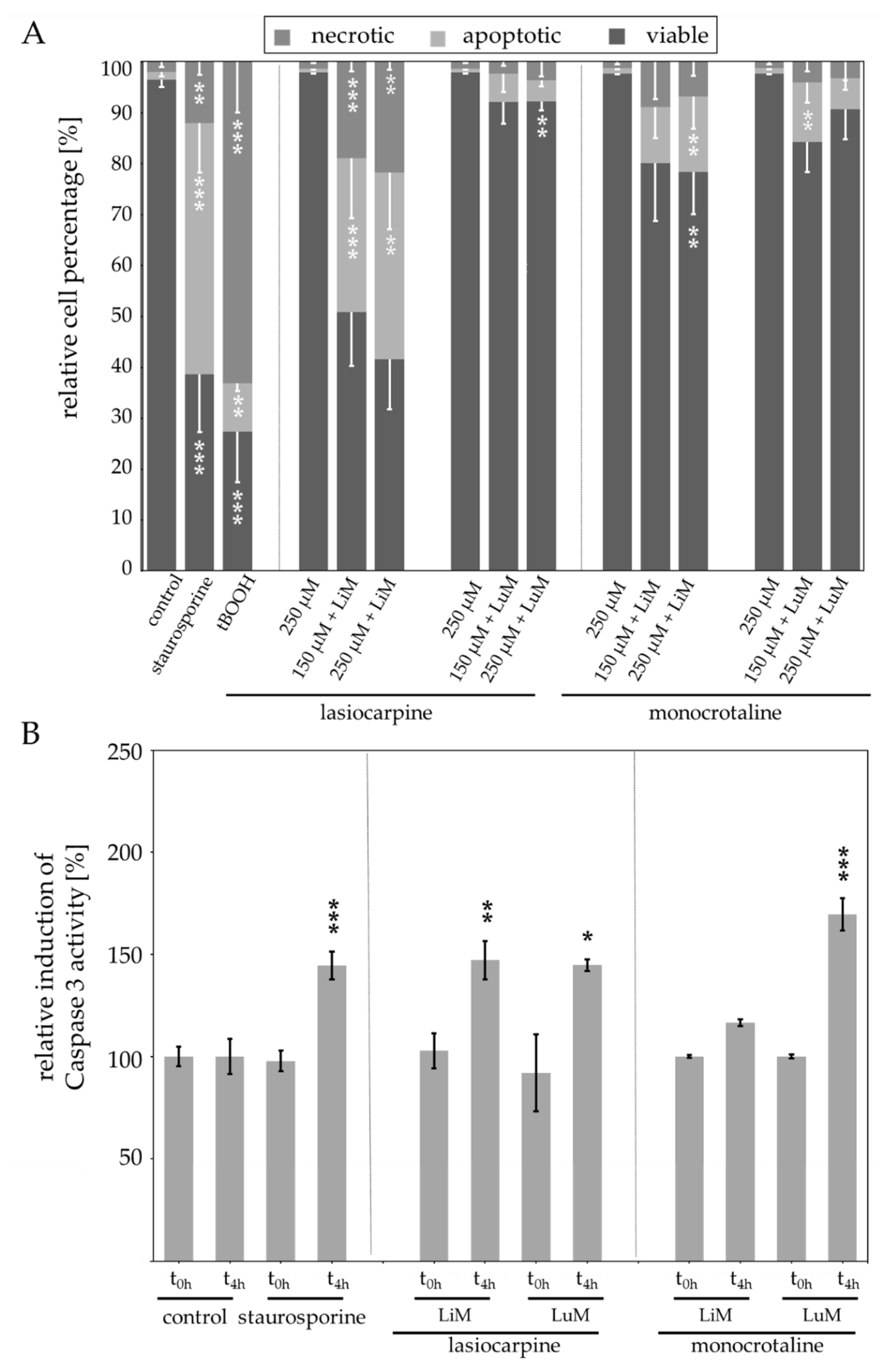
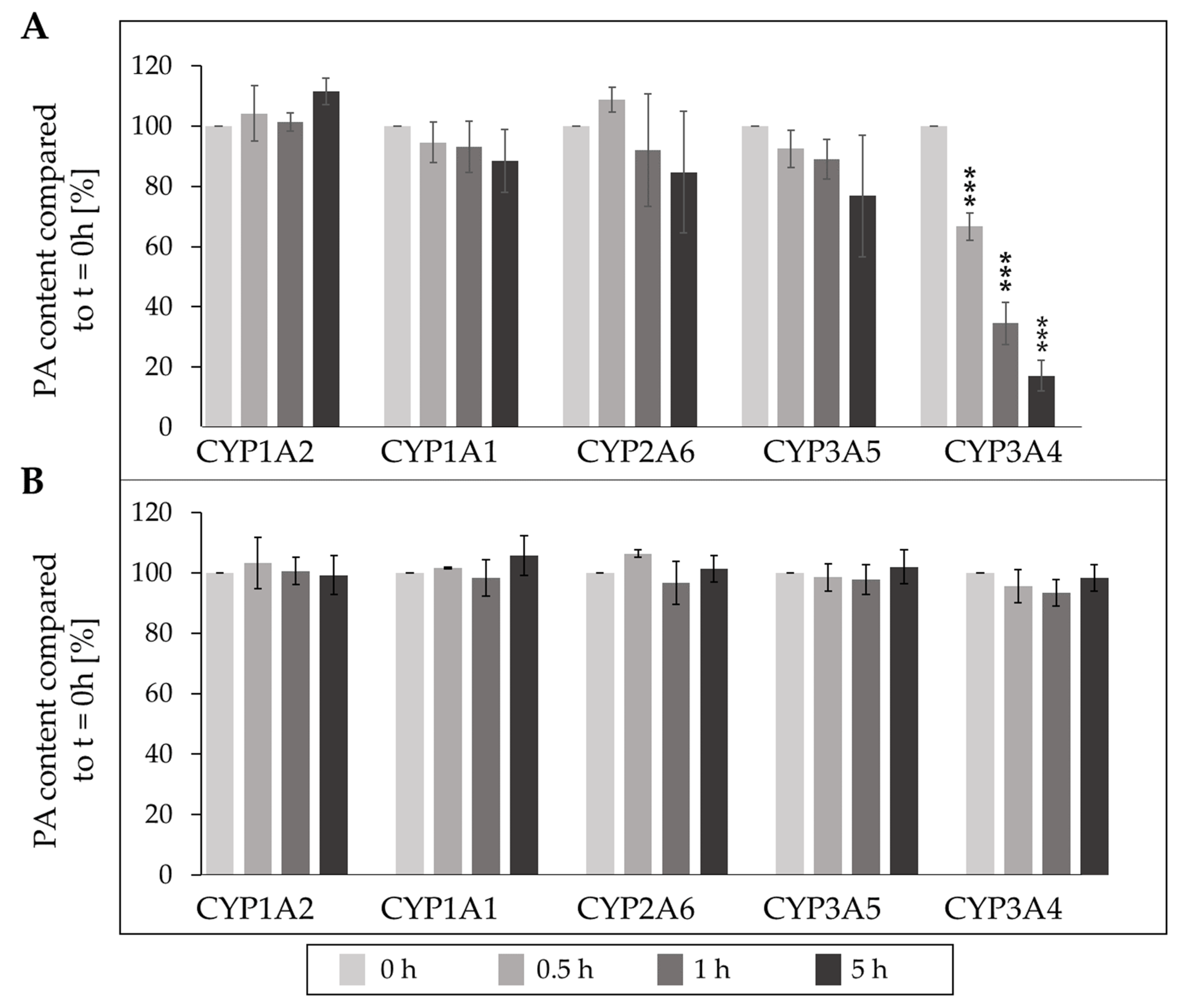
Publisher’s Note: MDPI stays neutral with regard to jurisdictional claims in published maps and institutional affiliations. |
© 2022 by the authors. Licensee MDPI, Basel, Switzerland. This article is an open access article distributed under the terms and conditions of the Creative Commons Attribution (CC BY) license (https://creativecommons.org/licenses/by/4.0/).
Share and Cite
Buchmueller, J.; Kaltner, F.; Gottschalk, C.; Maares, M.; Braeuning, A.; Hessel-Pras, S. Structure-Dependent Toxicokinetics of Selected Pyrrolizidine Alkaloids In Vitro. Int. J. Mol. Sci. 2022, 23, 9214. https://doi.org/10.3390/ijms23169214
Buchmueller J, Kaltner F, Gottschalk C, Maares M, Braeuning A, Hessel-Pras S. Structure-Dependent Toxicokinetics of Selected Pyrrolizidine Alkaloids In Vitro. International Journal of Molecular Sciences. 2022; 23(16):9214. https://doi.org/10.3390/ijms23169214
Chicago/Turabian StyleBuchmueller, Julia, Florian Kaltner, Christoph Gottschalk, Maria Maares, Albert Braeuning, and Stefanie Hessel-Pras. 2022. "Structure-Dependent Toxicokinetics of Selected Pyrrolizidine Alkaloids In Vitro" International Journal of Molecular Sciences 23, no. 16: 9214. https://doi.org/10.3390/ijms23169214
APA StyleBuchmueller, J., Kaltner, F., Gottschalk, C., Maares, M., Braeuning, A., & Hessel-Pras, S. (2022). Structure-Dependent Toxicokinetics of Selected Pyrrolizidine Alkaloids In Vitro. International Journal of Molecular Sciences, 23(16), 9214. https://doi.org/10.3390/ijms23169214





